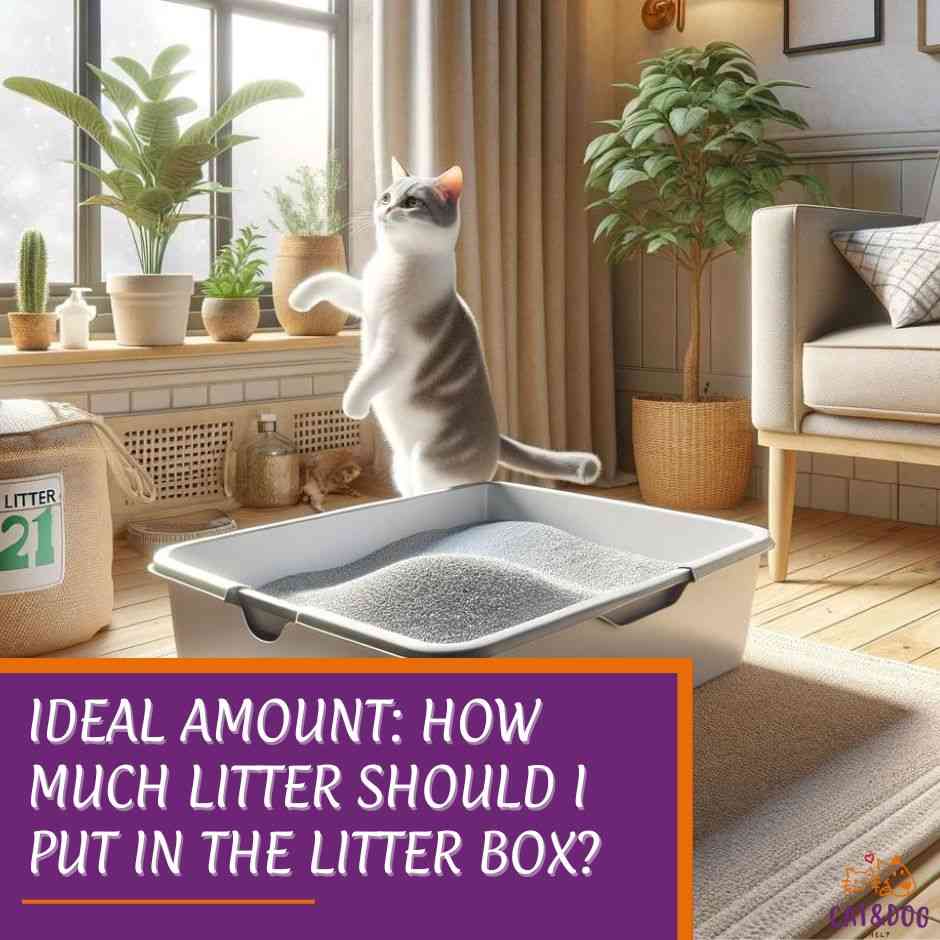Pet parents, do you ever wonder, “How much litter should I put in the litter box?”
Maintaining the litter box is not just an essential chore; it’s key to your cat’s comfort and health. Let’s be honest, it makes your life a lot easier too.
Have you ever found yourself staring at the numerous options of litter at the store, wondering just how much of it should actually go into the litter box?
It’s a common question among cat owners because, much like Goldilocks encountering porridge, you want the amount to be just right.
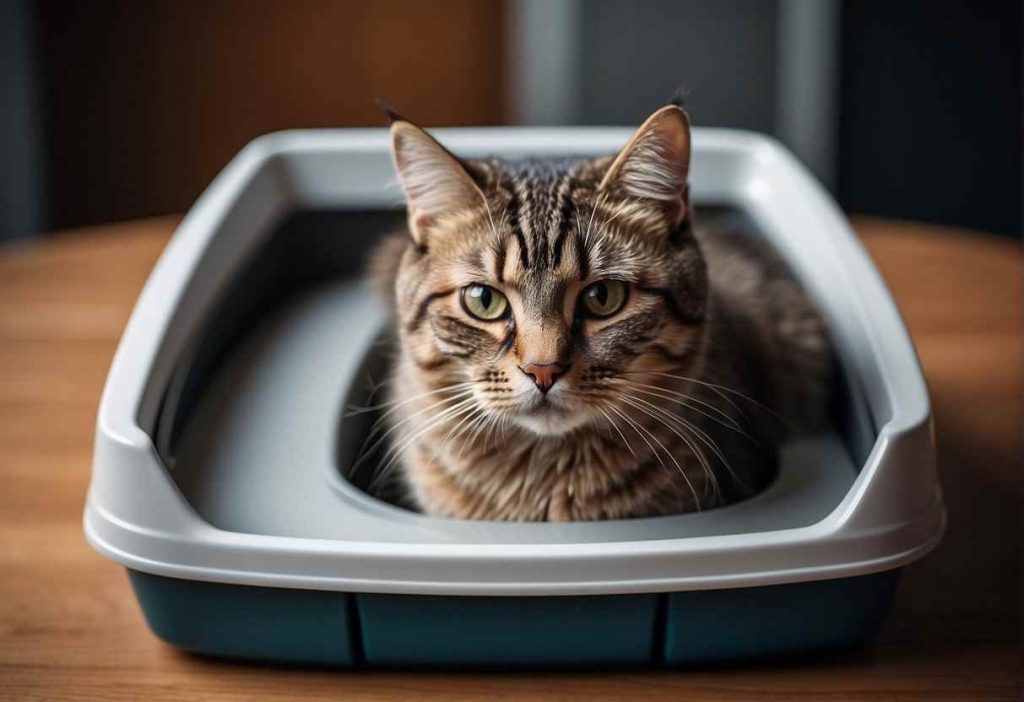
Some experts agree that the sweet spot for litter depth is around 2 to 3 inches. (1)
It’s enough for your furry friend to dig and bury their business without hitting the bottom, but not so much that it leads to wastage or a mess.
Sure, every kitty has their aristocratic preferences, so you might need to tweak this a bit.
Consider this article your GPS on the road to litter box perfection, guiding you through the twists and turns of types of litter, box choices, and yes, even those advanced tactics for keeping things fresh.
Key Takeaways
- A proper litter depth of 2 to 3 inches suits most cats’ needs and prevents waste.
- Choosing the right litter and box combined with maintenance strategies ensures a clean environment for your cat.
- The article aims to deliver trusted advice and actionable tips for optimal litter box management.
How Much Litter Should I Put in the Litter Box: Determining the Correct Amount
Ideally, the sweet spot for litter depth is between 3-4 inches. This depth is like the Goldilocks zone; not too much, not too little, just right for your cat’s digging and burying rituals.
But here’s a pro tip: always keep in mind that every cat has their own unique personality.
If your kitty is a little pickier or perhaps more vigorous in their bathroom activities, adjusting the depth by an inch or so might just be purr-fect.
Wondering if you’re pouring too much or too scanty litter? Let’s decode some feline mysteries.
- Too Much Litter: Your cat might look like an archeologist, excavating ancient ruins every time it tries to bury its business. Overfilled litter can also make it difficult for your kitty to find a solid footing.
- Too Little Litter: This is the scene of a crime where the waste remains unburied, leaving a not-so-pleasant calling card in terms of odor and cleanliness.
If you’re noticing these signs, it’s time for a little adjustment.
If your cat is constantly kicking litter out or seems hesitant to step in, try reducing the amount.
On the flip side, if your fussy feline refuses to use the litter box or the waste isn’t sufficiently covered, it might be time to add an inch of extra litter.
Keep an eye on your cat’s behavior—they’re the best indicator of the litter level they love!
Remember, there’s no one-size-fits-all. Finding the perfect amount of litter is a bit like tailoring a suit; it needs to fit just right for your particular cat’s comfort and habits.
Keep these guidelines in hand, and you’ll be the cat’s meow of litter box maintenance!
Choosing the Right Type of Cat Litter

When you’re on the hunt for the perfect cat litter, the variety can be a bit overwhelming, right? There’s clay, silica, biodegradable… and within each type, there are another dozen options. Let’s break it down:
Clay Litter:
- Pros: Highly absorbent, offers good odor control and comes in clumping or non-clumping varieties.
- Cons: Can be dusty, may not be the best for sensitive paws, and isn’t biodegradable.
Silica Gel Litter:
- Pros: Super absorbent, controls odor well, and produces less dust compared to clay.
- Cons: It’s more expensive and some cats might not like the texture.
Biodegradable Litter (e.g., corn, wheat, walnut shells):
- Pros: Eco-friendly, often flushable, and can be good for cats with allergies.
- Cons: May not clump as well as clay, potential for spoilage, and might attract bugs.
So, which one is your furball going to prefer? It might take some experimentation. Cats can be finicky with their bathroom habits!
Product Face-off
Time for a quick showdown between two popular cat litter types. Clumping Clay Litter and Silica Gel Litter:
| Feature | Clumping Clay Litter | Silica Gel Litter |
| Odor Control | Good | Excellent |
| Clumping | Strong, firm clumps | Non-clumping |
| Dust Production | Moderate to high | Low |
| Price | Budget-friendly | Higher priced |
Choosing the right litter isn’t just a box-ticking exercise—it can seriously affect your cat’s loo behavior.
Found one that ticks all the right boxes? Great! Remember, the goal is a happy cat and a clean house. Good luck finding the purr-fect match!
Selecting the Ideal Litter Box
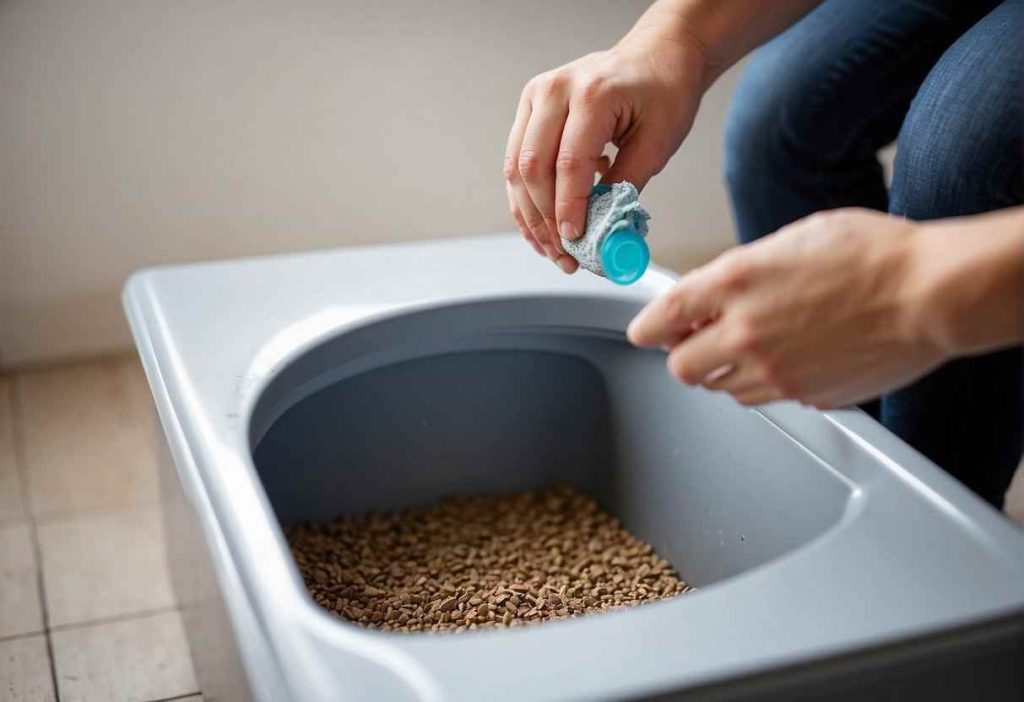
Pros and Cons of Different Litter Box Designs:
- Open Litter Boxes:
- Pros: Open access for your cat, better ventilation, easy to clean. (2)
- Cons: Less privacy for your kitty and more potential for litter scatter.
- Hooded Litter Boxes:
- Pros: Offers privacy, and helps contain odors and litter.
- Cons: Can be tricky for larger cats to enter and might not be well-ventilated.
- Self-Cleaning Litter Boxes:
- Pros: Convenience, less hands-on cleaning.
- Cons: May scare some cats, and they come with a higher price tag.
Matching Litter Box Types to Your Cat’s Preferences:
- Size Matters: Large cats or those who love ample space tend to prefer open or oversized boxes. (3)
- Age & Health: Kittens or cats with mobility issues? Low-sided boxes are your go-to. (4)
- Shy Guys & Gals: Reserved felines might appreciate the solitude of a hooded box.
Remember, there’s no one-size-fits-all answer here. You might need to test a few options before your cat votes with their paws on their palace of choice.
Keep an eye on how they interact with their box – it’s the best indicator that you’ve hit the jackpot!
When setting up your cat’s litter box, aim for 2-4 inches of litter to keep them happy and digging to their heart’s content.
Advanced Litter Box Maintenance Strategies
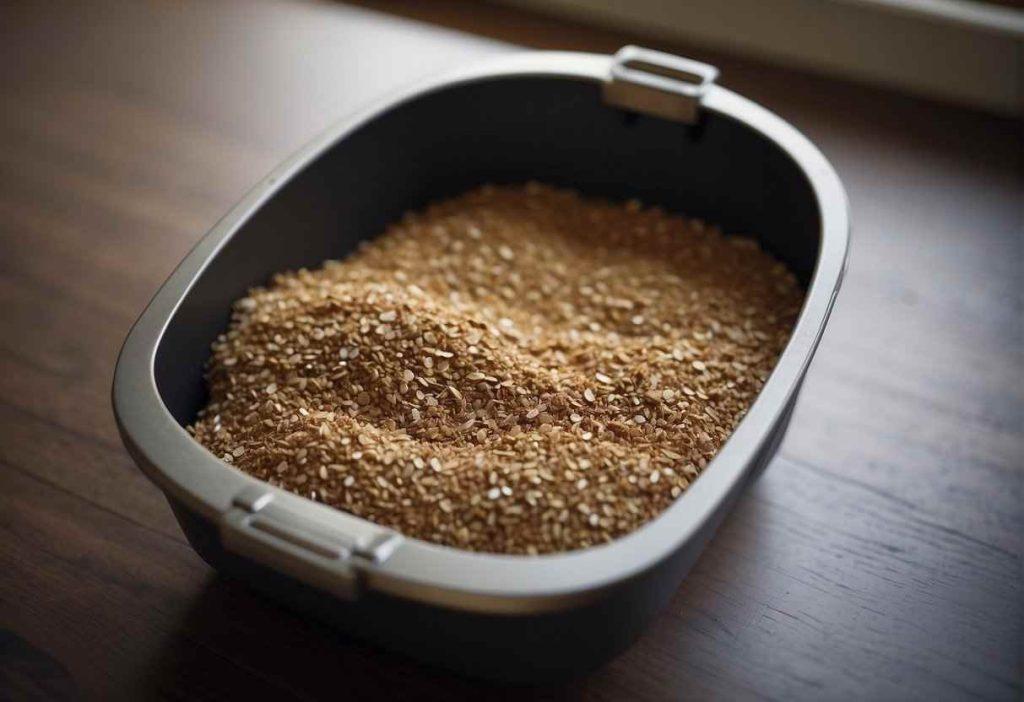
Let’s talk about preventing odor and managing litter tracking to make sure your home stays as fresh as your cat’s sanctuary.
- Daily Routine:
- Scoop out clumps and solid waste every day.
- Quick daily sweeps or a dedicated litter mat can catch tracked litter.
- Weekly Upkeep:
- Discard all litter and scrub the box with soapy water once a week.
- Activated charcoal filters or a sprinkle of baking soda can help with odor control.
Innovative Products:
- Litter box liners for quick changes.
- Top-entry or high-sided boxes to minimize spillage and tracking.
Trying to keep your furry friend happy? It’s not just about the litter itself; it’s also about the litter box environment. A poorly placed box can lead to unpleasant surprises elsewhere.
- Location, Location, Location:
- Privacy matters! Tuck the litter box away from high-traffic areas but ensure it’s easy for your cat to access.
- Creating a Cozy Corner:
- Place familiar towels or toys nearby to make the area welcoming.
Remember, every cat and home is unique, so you may need to test different strategies to find what works best for you and your whiskered roommate. Happy scooping!
Understanding and Addressing Cat Behavior
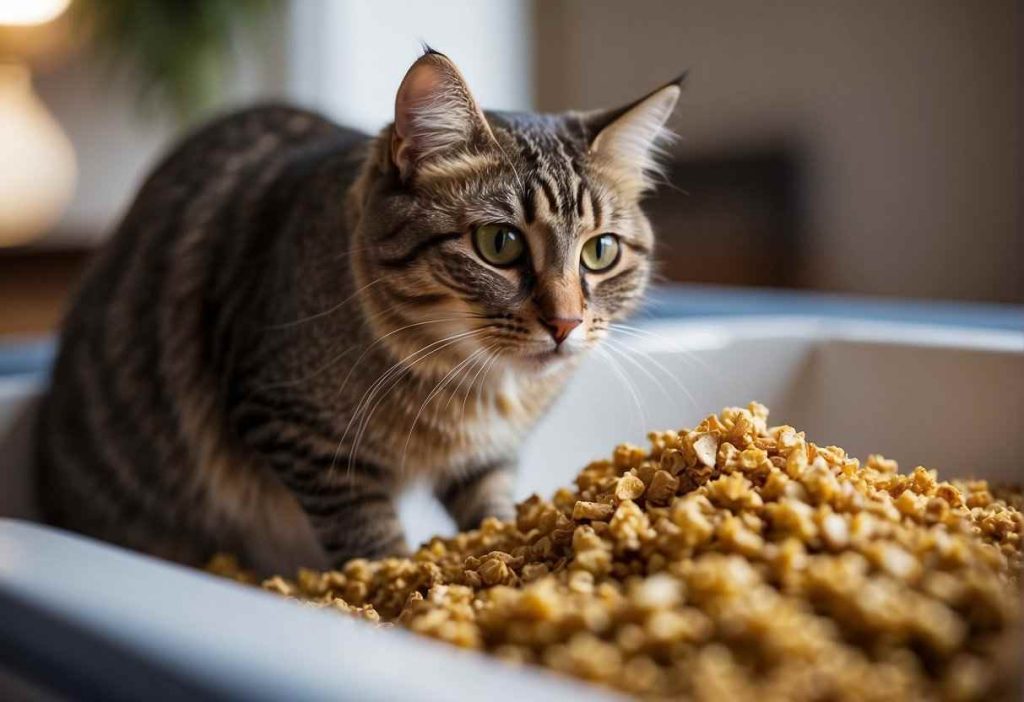
When you’re finding the sweet spot for litter in the box, have you ever wondered, “What’s going on inside my furry friend’s head?”
The truth is, that the amount of litter can influence your cat’s comfort and, ultimately, their box habits.
Why does depth matter?
Just like we have preferences for our pillows, cats have preferences for their litter.
A depth of 2-3 inches is typically recommended because it provides ample space for burying.
Sometimes, the Goldilocks effect kicks in – too little may not allow them to cover their business, and too much can feel overwhelming.
Types of Litter Boxes:
- Open: Freedom to move around.
- Covered: Provides privacy, might hold more odor.
Addressing Avoidance:
- Step 1: Assess the litter depth. Start with the 3 inches mark.
- Step 2: Notice their behavior. Are they digging into China or barely scratching the surface?
- Step 3: Adjust accordingly. Add or reduce by an inch and observe.
If your cat still acts like the box is lava, it’s time to play detective. Is it the box location, the litter type, or perhaps the cleanliness?
Cats are particular, and if something’s off, they’ll let you know in the least convenient ways possible.
Litter Box Quick Fixes:
- Cleanliness: Keep it scooped daily. (5)
- Privacy: Keep it in a quiet spot.
- Multiple Cats: One box per cat plus one extra is the golden rule. (6)
Remember, patience is key.
You wouldn’t want someone to rush you while doing your business, so give your cat the same courtesy.
Here’s a toast to a happy cat and a fresh-smelling home!
Evidence-Based Recommendations
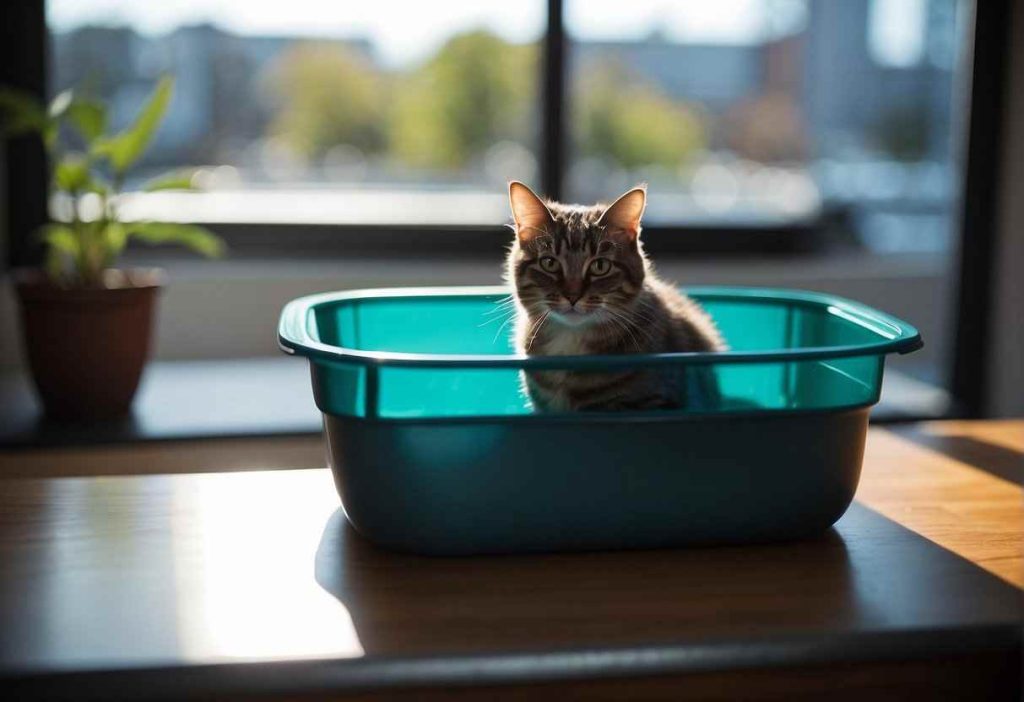
Managing a litter box can be a bit like a science project, but it’s crucial for your furry friend’s comfort and bathroom habits.
Let’s dig into what experts and fellow cat owners say:
- Depth Matters: Generally, 3 to 4 inches of litter is the sweet spot. It’s deep enough for your cat to bury their business, just how they like it! (7)
- Size Counts Too: Of course, if you’re “parenting” a more enthusiastic digger or have a larger litter box, feel free to go up to 4 inches.
- Less Could Be More: But why not just fill it to the brim?
- Cats, like royalty, prefer their thrones to be just right—not overflowing. Overfilling can lead to unwanted mess outside the box.
- The Golden Ratio: One box per cat, plus one extra, ensures everyone has their personal potty—and prevents any corner-cutting on cleanliness.
Remember, while these numbers are a great guide, they’re just a starting point.
Pay attention to your cat’s behavior. Are they a casual scratcher or a feline archaeologist on a digging spree? Adjust accordingly.
And let’s be real, keeping that litter box pristine speaks volumes of your love—a little scooping effort means a lot of purring appreciation.
| Number of Cats | Number of Litter Boxes | Suggested Litter Depth |
| 1 | 2 | 2-3 inches |
| 2 | 3 | 2-3 inches |
| 3+ | 4+ | 2-3 inches (or 4 inches for diggers) |
A clean, well-maintained litter box? That’s the real cat’s pajamas! Keep it fresh, and your whiskered pal will be forever grateful.
Quick Recap

Let’s quickly go over the golden nuggets of keeping your kitty’s bathroom tiptop. You’ve got this, right?
- Firstly, 3 to 4 inches of litter is the sweet spot. It’s like a cozy bed for your cat’s paws—enough to dig but not so much that you’re wasting litter.
- Remember, cat’s preferences matter. Some like to excavate to China, others barely scratch the surface. Watch your furball’s habits and adjust accordingly.
- The type of litter can change the game. Clumping, non-clumping, scented, or tofu (!)—options abound, but your cat will likely vote with their paws.
- Size matters with litter boxes. More space means more room to cover their tracks. A larger box might mean a bit more litter required to hit that 2 to 4-inch mark.
And now for the fun part—experiment!
Shuffle those litters, switch up quantities, and observe. Your furry detective will inevitably lead you to the purr-fect setup.
Curious about how others do it or have a game-changing tip? Share it with the community! We’re all ears (and paws) here.
Frequently Asked Questions

Navigating the world of cat litter can seem like a puzzle, but don’t worry—you’re not alone in your curiosity.
Let’s answer some common litter box questions with clear, precise info to keep your feline friend happy and your home fresh.
What is the ideal amount of litter to use for one cat?
For your solo furball’s litter box, 3-4 inches of litter is typically just right.
This allows your cat to comfortably dig and bury, without the litter being too shallow or so deep it goes to waste.
Can you recommend some tips for maintaining a self-cleaning litter box?
Of course! Regularly check that the rake is free of debris and wipe down sensors or cameras if your model has them.
Ensure you’re using a compatible litter type, as some boxes have specific requirements.
How often should litter in a kitten’s box be replaced?
Kittens require frequent changes—usually, the entire litter box should be replaced twice a week.
This prevents the buildup of bacteria and helps establish good hygiene habits early on.
Is there such a thing as using too much litter in my cat’s litter box?
Indeed, too much litter can be wasteful and cause a mess outside the box as your kitty kicks it out.
It can also make self-cleaning mechanisms jam if you have an automated box.
Can I mix different types of litter?
While you may be tempted to turn your cat’s box into a cocktail of litters, it’s best not to.
Different litters may clump, absorb, or react differently, possibly deterring your cat from using the box.
What to do if my cat dislikes its litter box?
First, ensure the box is kept clean and approachable.
Try changing the location, type of litter, or even the box itself—some cats prefer an open box over an enclosed one, and vice versa.
What’s the safest way to dispose of used cat litter?
Seal soiled litter in a biodegradable bag and toss it in your trash bin.
Avoid flushing it, even if it’s labeled flushable, to prevent plumbing issues and environmental contamination.
- How to Perform at an Online Casino - July 7, 2025
- Free Slots With Bonus and Free Spins - July 6, 2025

